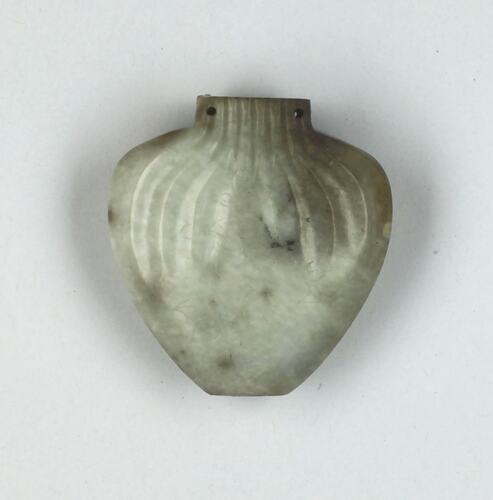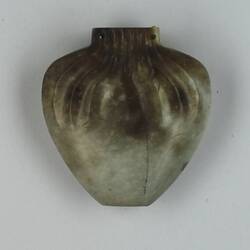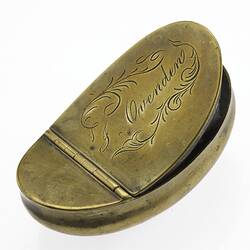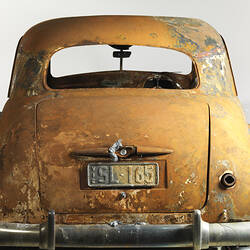Summary
Carved jade snuff bottle, found in the ashes of Viewfield, a house in Mt. Macedon owned by John and Zelma Gartner, after the Ash Wednesday bushfires of 1983. This is a remnant of a collection of miniature objects assembled by Zelma Gartner, all of which were lost in the fire. The small community of Mt Macedon, northwest of Melbourne, was engulfed by bushfire on the night of 16 February, when a late wind change directed the fire from East Trentham up onto the mountain. 7 people died and 628 homes were destroyed in East Trentham and Mt Macedon.
Although the heat of the fire vapourised silver and melted glass, the bottle has suffered only discolouration and the loss of a fine cord that was threaded through holes on the shoulders of the container. There would also have been a stopper made of coral, but this too disappeared in the fire.
Snuff bottles were used by the Chinese to carry powdered snuff and were frequently beautifully carved and decorated. This one is made of pale green jade and has fluted shoulders and incised carvings on both sides. The delicate line etchings depict a lotus blossom, a symbol of purity in many Asian traditions and a flower frequently associated with Buddha.
Physical Description
Light green jade bottle with fluted shoulders and incised decoration on both sides of lotus blossoms. There are two holes on each side of the opening for a cord to be threaded through; both the cord and the original stopper are missing. One side is fire-blackened.
Significance
The Ash Wednesday bushfires of February 1983 were one of Australia's greatest natural disasters Fires swept through Victoria and South Australia. In the space of a single day in Victoria, 47 people were killed and nearly 3000 homes and other buildings were destroyed. This object, along with others from the same house, demonstrates the severity and extent of the fire in Mt Macedon. It is an eloquent symbol of the destruction of the specific property in which it was found, but it also represents the universal power of fire to irrevocably change objects, homes, and lives.
More Information
-
Collection Names
-
Collecting Areas
-
Acquisition Information
Donation from Mrs Zelma Gartner, 16 Mar 2011
-
Past Owner
John Gartner, Mount Macedon, Victoria, Australia, 16 Feb 1983
-
Past Owner
Mrs Zelma Gartner, Mount Macedon, Victoria, Australia, 16 Feb 1983
-
Classification
-
Category
-
Discipline
-
Type of item
-
Overall Dimensions
52 mm (Width), 22 mm (Depth), 48 mm (Height)
-
References
[Link 1] (accessed 08/01/12)
-
Keywords
Ash Wednesday Bushfires, 1983, Bushfires, Minerals, Snuff Boxes




